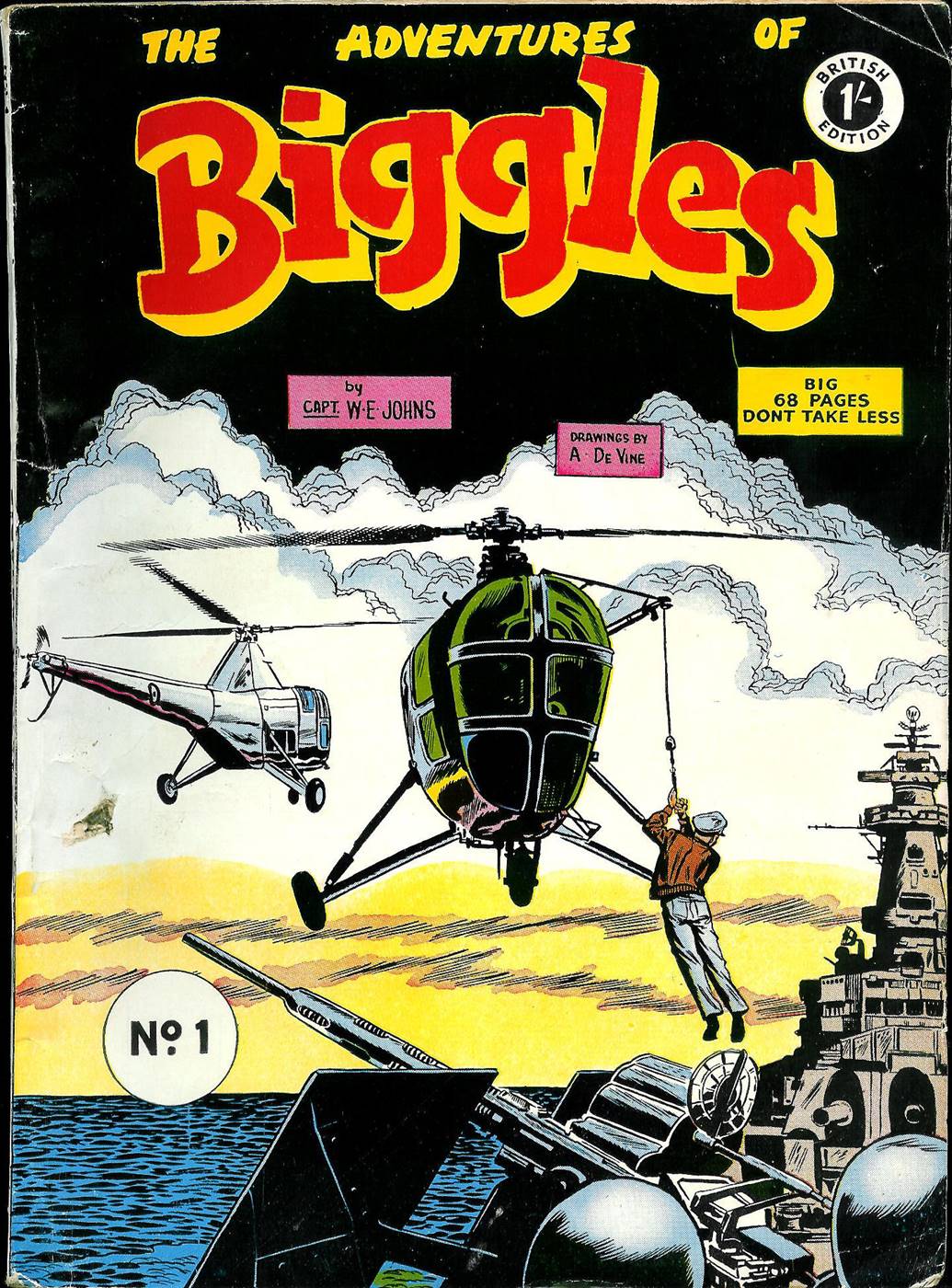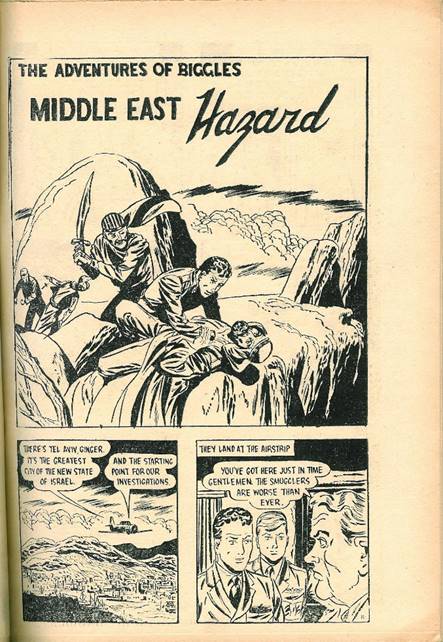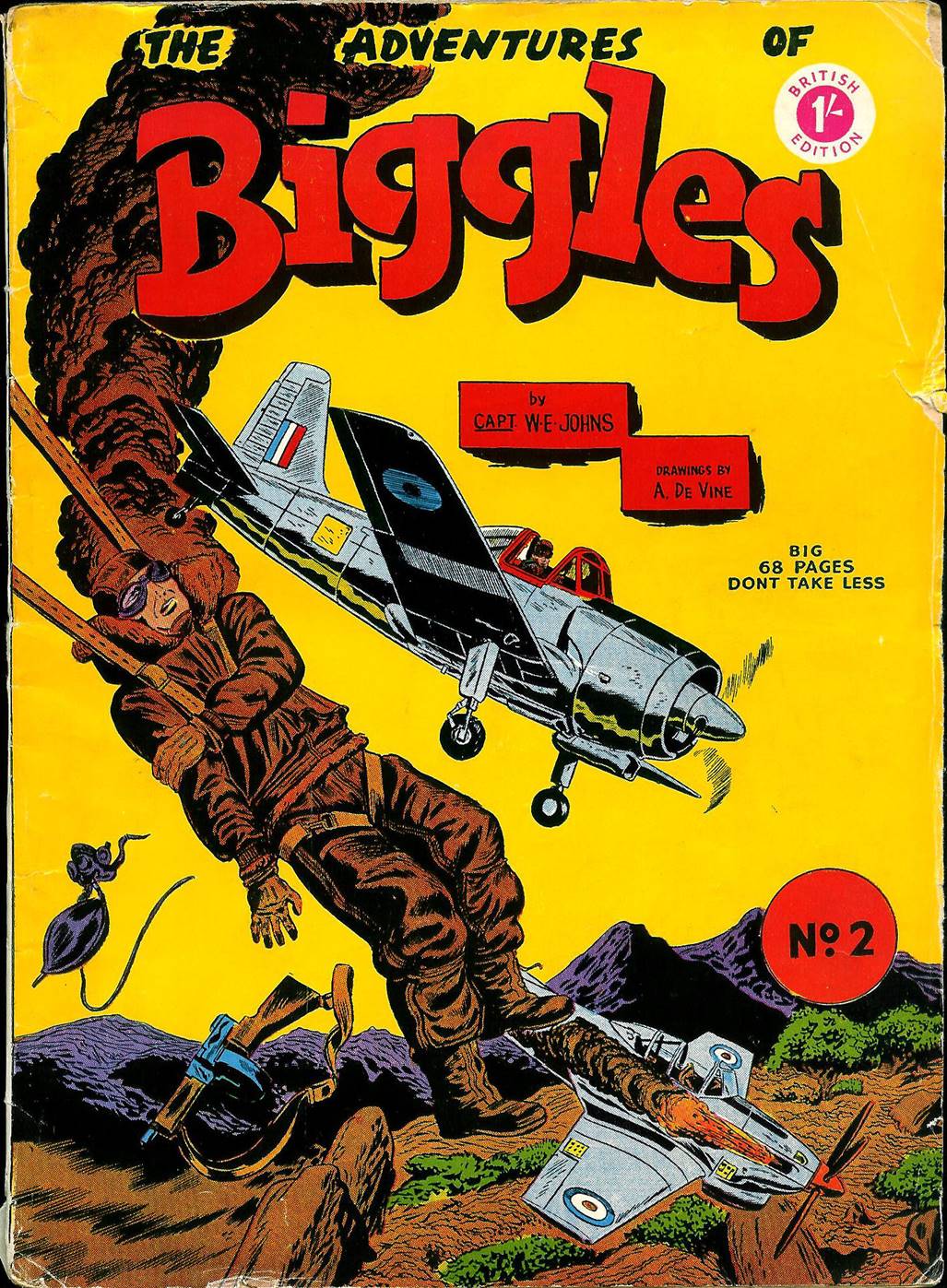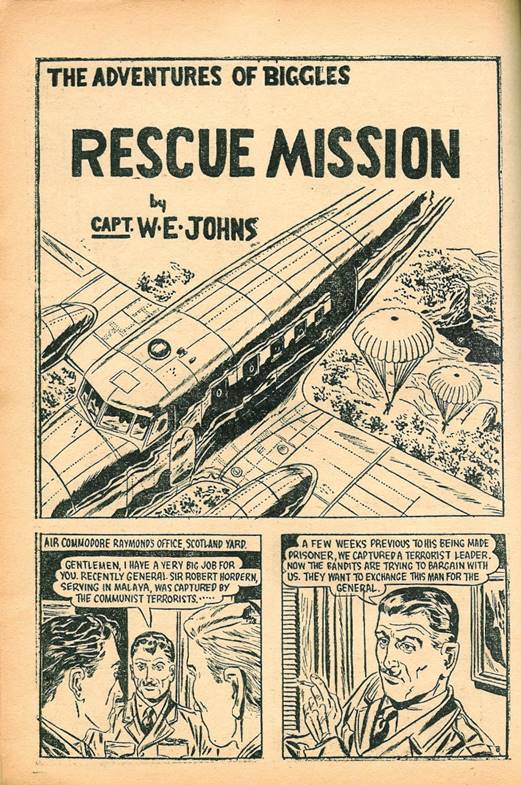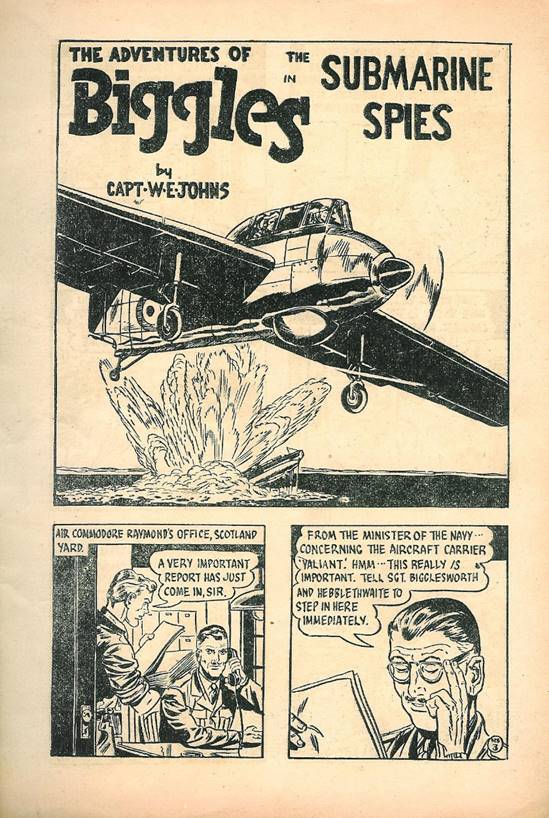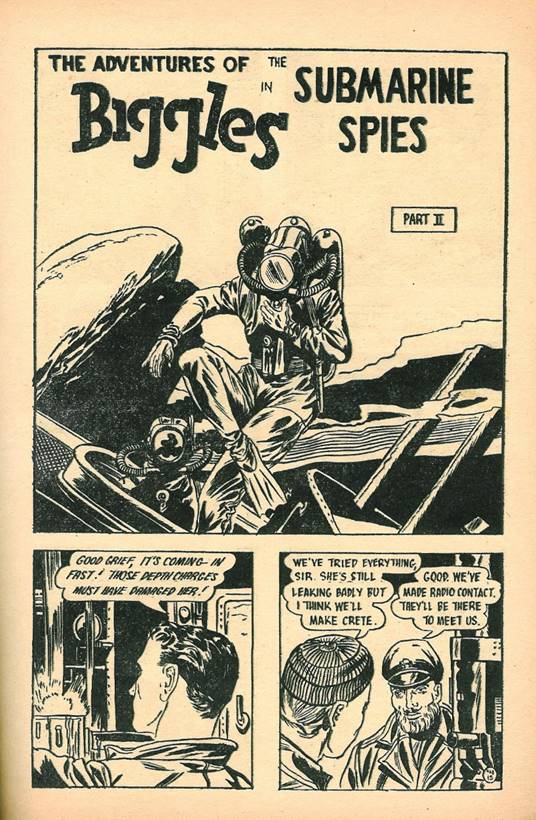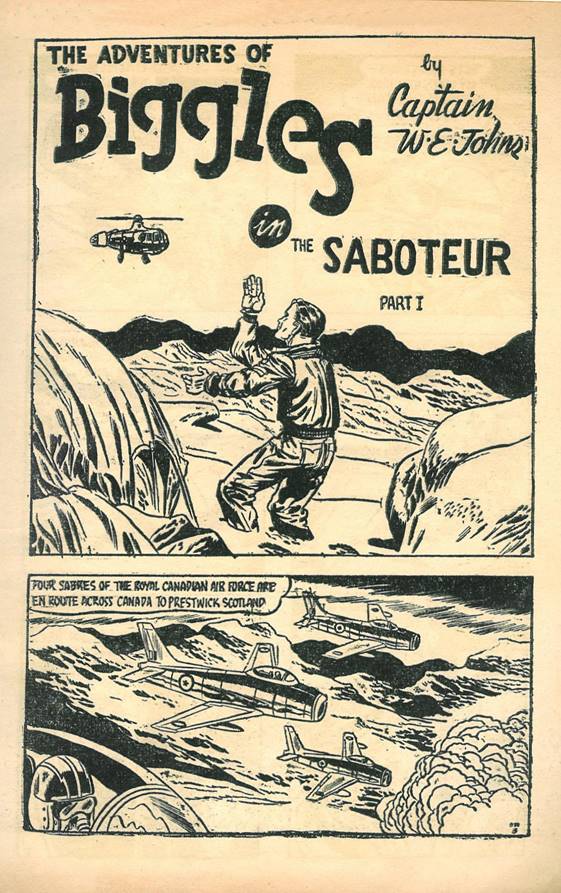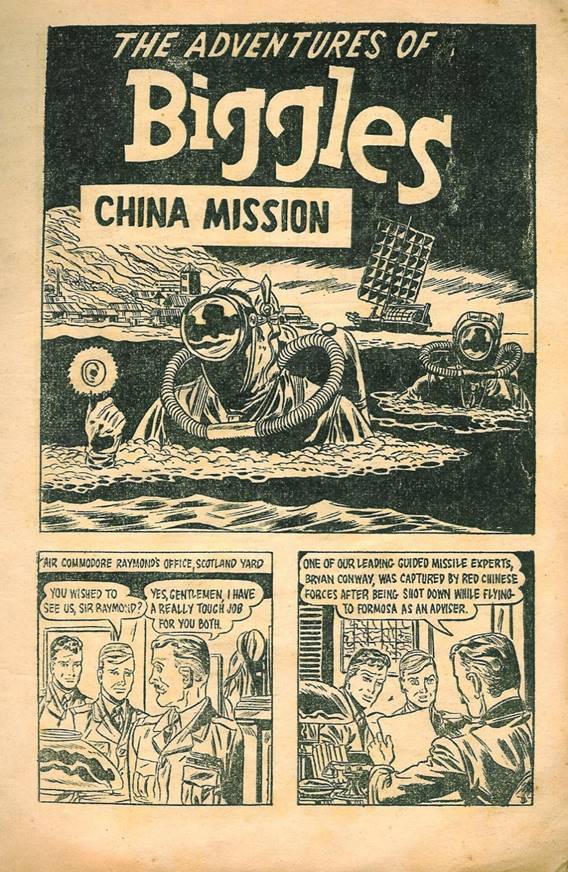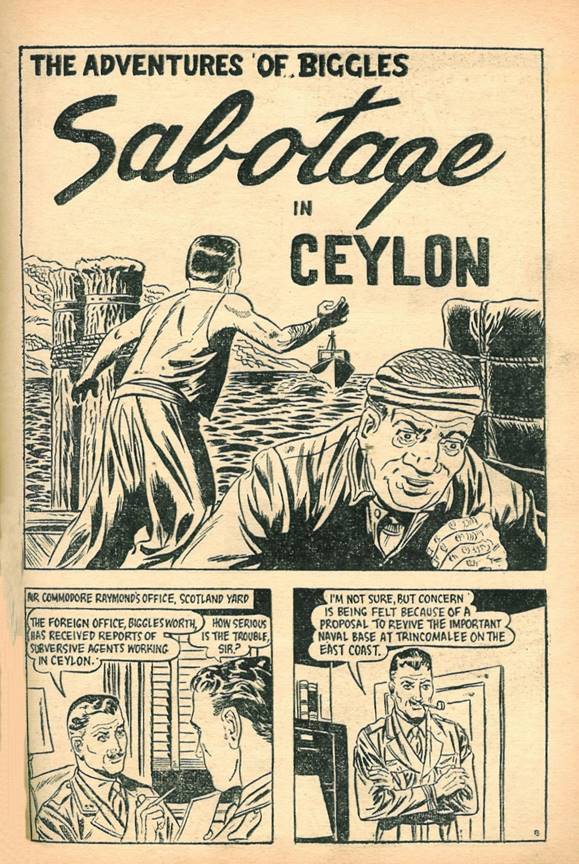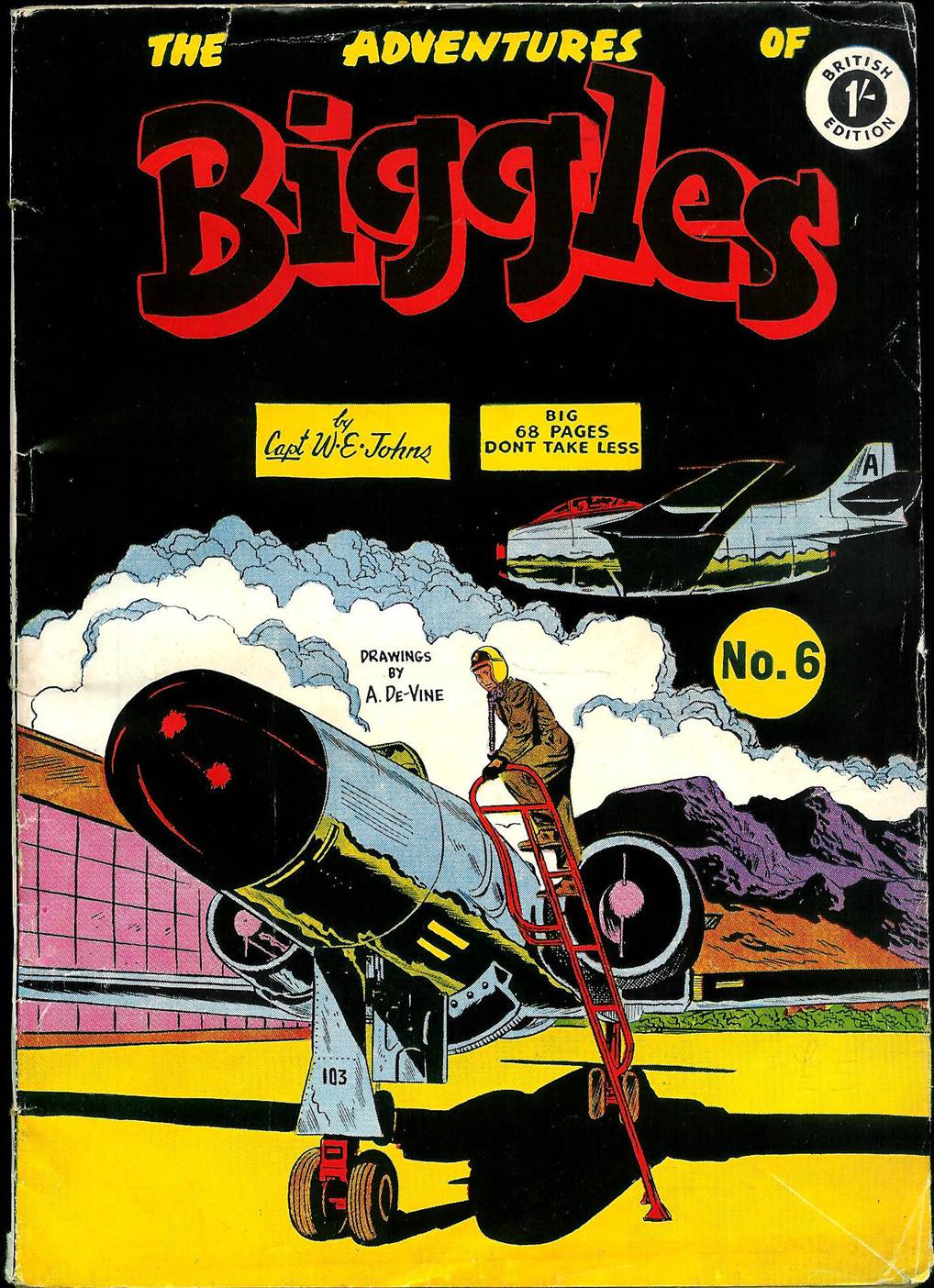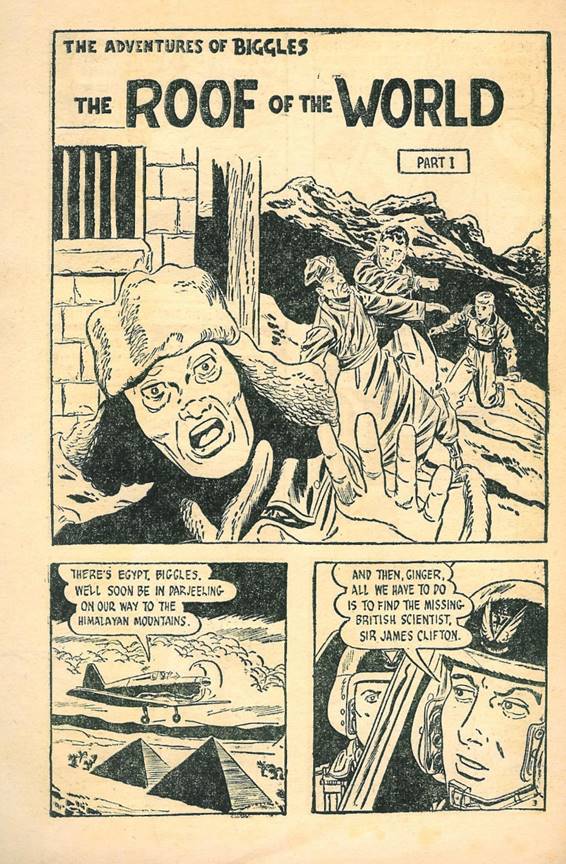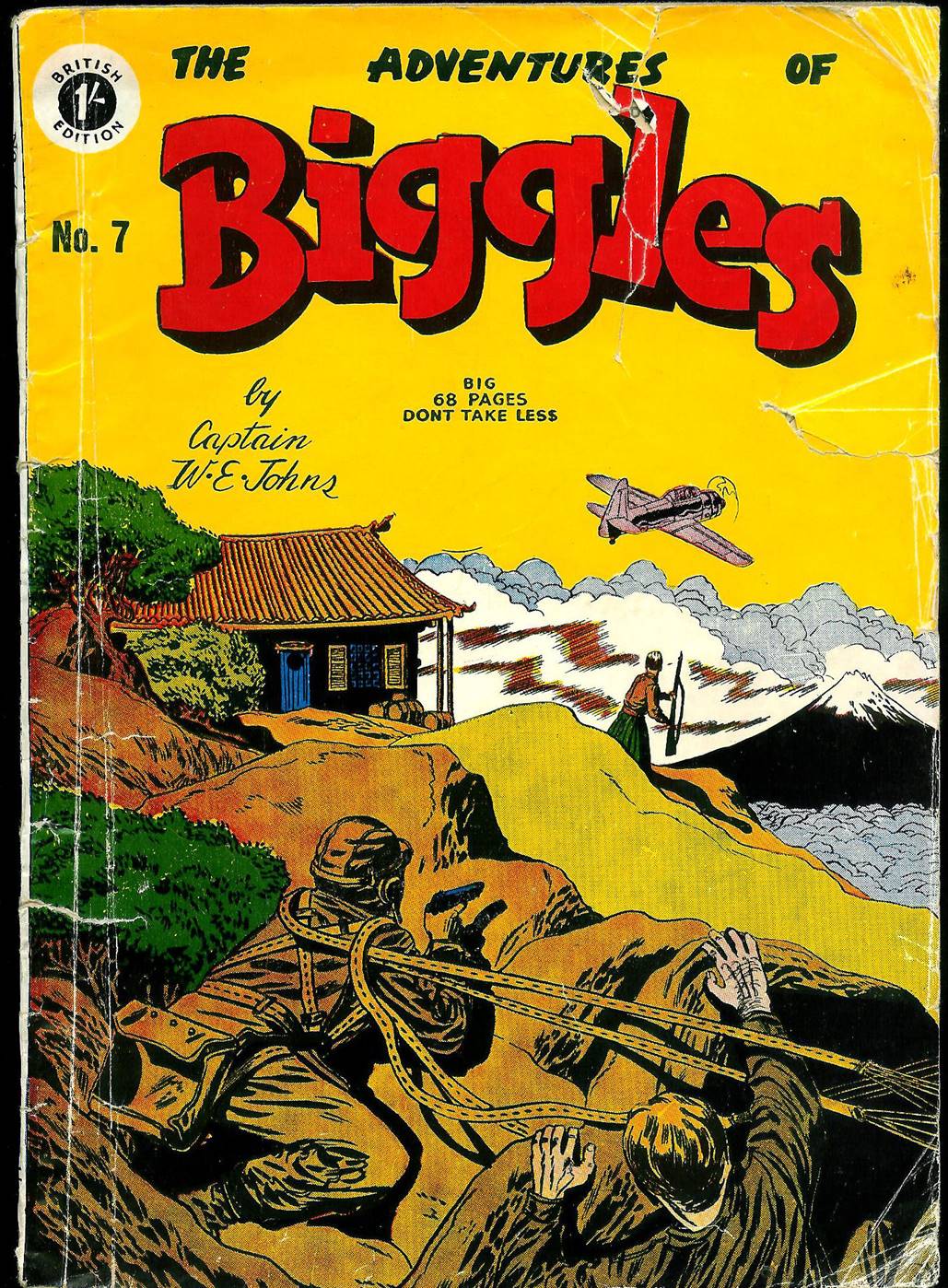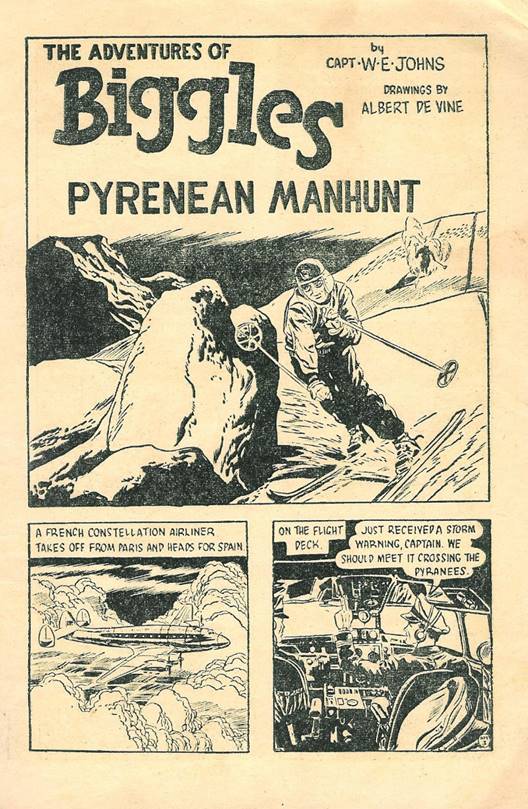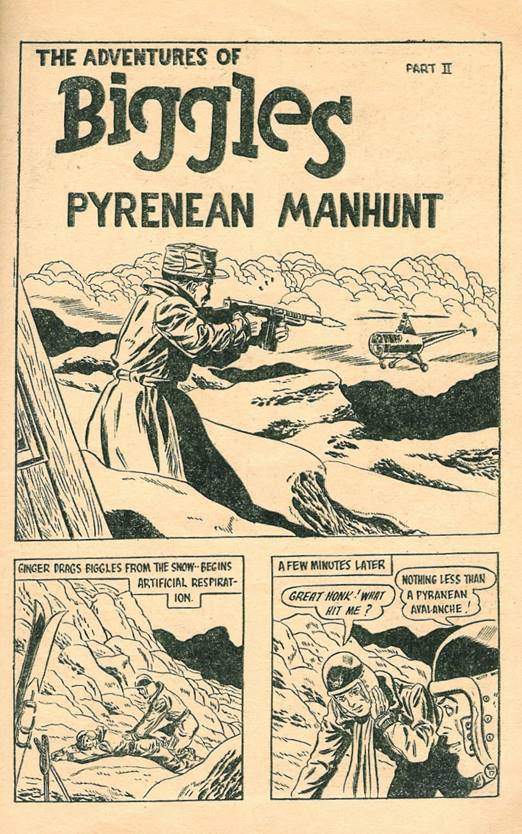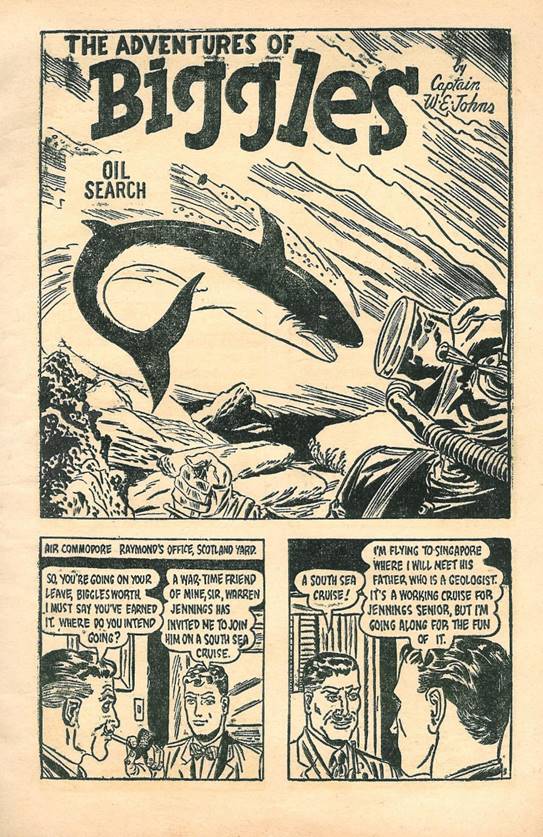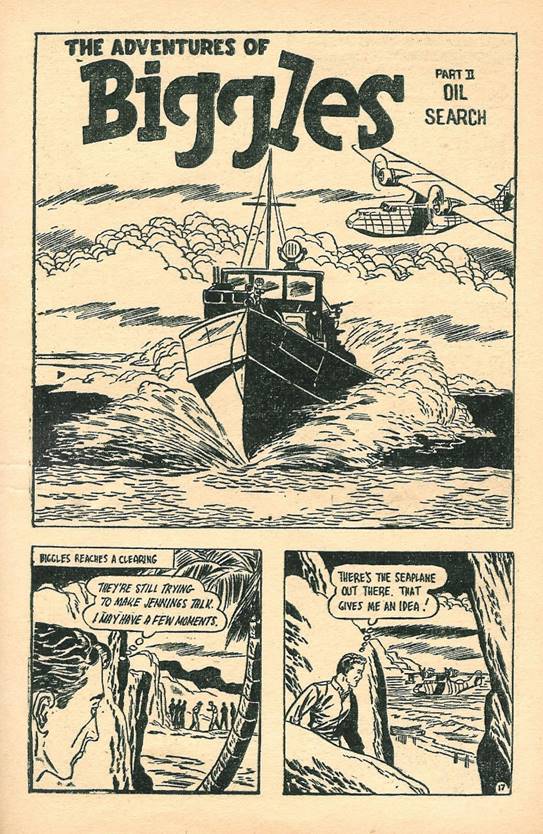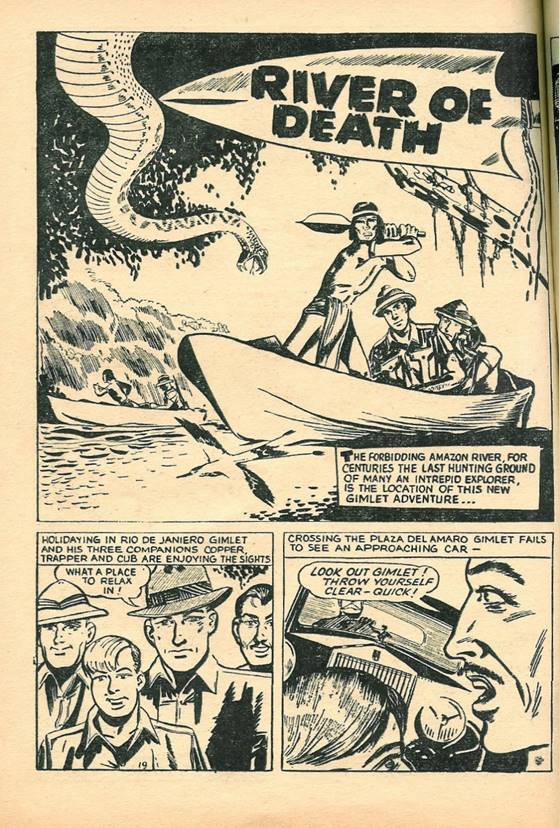THE ADVENTURES OF
BIGGLES
THERE WAS AN
AUSTRALIAN COMIC IN THE 1950’S THAT RAN TO About 78 ISSUES AND CONTAINED A
MIXTURE OF
“W.E. Johns” biggles
stories and stories written by others especially for the comic.
THEY WERE PUBLISHED
BY ACTION COMICS PTY. LTD (SYDNEY)
You can read more about the Australian comics here
there was an attempt
to publish stories from this Australian comic in the uk.
It was apparently
unsuccessful as only nine issues of the “British edition” of the comic were ever published.
This web page
displays those nine issues and gives guide to the contents.
Published by “strato
publications ltd., London. W.1” –
drawings are credited to “albert de vine”
Each magazine was
9.5 inches by 7 inches or 24.5 cm x 18 cm
(Click on any
image to enlarge it)
|
This British Issue Number 1 uses the Australian cover illustration from Issue 19 |
Issue one of “The
Air Adventures of Biggles” is undated.
It was published in the UK in the 1950s – if anyone knows the exact date, then
please contact me. Issue one
contained 68 pages (but this includes the cover pages, so there were only 64
pages inside the covers) and FIVE stories. The first
three stories were “Biggles” stories and you can see the first pages of those
three stories above. Obviously the
second story was a continuation of the first. |
The first part
of “The Kidnapped Scientist” ran to 15 pages The second part
of “The Kidnapped Scientist” ran to 9 pages “Middle East
Hazzard” ran to 12 pages |
There were
then two other cartoon stories which were “non-Biggles” stories and hence
they are not illustrated here. “Tim Valour –
Commander of the Famous Tigerhawks” by John Dixon ran to 14 pages “The Crimson Comet - Operation Earthquake” by John Dixon ran to 14 pages. (The Crimson Comet appears to be a ‘Dan Dare’ type character in a birdman ‘superhero’ costume). |
|
This British Issue Number 2 uses the Australian cover illustration from Issue 20 |
Issue two of
“The Air Adventures of Biggles” is again undated. It also ran to
68 pages (including the
covers) This time there are only two “Biggles” stories and three other stories in the comic. |
“Indo China
Intrigue – Part I” ran to 21 pages.
(Although the first page of the story says that this is “Part 1” this
was printed as a complete story and the page count seems to indicate that two
parts were printed together) “Rescue
Mission” ran to 10 pages |
There were
then THREE other cartoon stories which were “non-Biggles” stories Again, they
are not illustrated “The Crimson
Comet” (uncredited) ran to 11 pages “Tim Valour – Commander
of the Famous Tigerhawks” by John Dixon ran to 11 pages “The Crimson
Comet” (uncredited) ran to 11 pages |
|
This British Issue Number 3 uses the Australian cover illustration from Issue 21 |
Issue three of
“The Air Adventures of Biggles” is again undated. It also ran to
68 pages (including the
covers) There are three “Biggles” stories and two other stories in the comic. |
“The Submarine
Spies – Part I” ran to 12 pages (although the title doesn’t include the words
“Part I”) “The Submarine
Spies – Part II” ran to 12 pages “The Pirate
Sub” ran to 12 pages |
The two other
cartoon stories were “non-Biggles” stories and hence they are not illustrated
here. “The Crimson
Comet” by John Dixon ran to 14 pages “Tim Valour –
Commander of the Famous Tigerhawks” by John Dixon ran to 14 pages |
|
This British Issue Number 4 uses the Australian cover
illustration from Issue 22 |
Issue four of “The
Air Adventures of Biggles” is again undated. It also ran to
68 pages (including the
covers) There are three “Biggles” stories and two other stories in the comic. |
“The Saboteur
– Part I” ran to 14 pages “The Saboteur
– Part II” ran to 10 pages “The Missing
Cameraman” ran to 12 pages |
The two other
cartoon stories were “non-Biggles” stories and hence they are not illustrated
here. “Tim Valour –
Commander of the Famous Tigerhawks - Betrayed” by John Dixon ran to 14 pages “The Crimson
Comet” (uncredited) ran to 14 pages. |
|
This British Issue Number 5 uses the Australian cover illustration from Issue 23 |
Issue five of
“The Air Adventures of Biggles” is again undated. It also ran to
68 pages (including the
covers) There are three “Biggles” stories and two other stories in the comic. |
“China Mission
– Part I” ran to 13 pages (although the title doesn’t include the words “Part
I”) “China Mission
– Part II” ran to 11 pages “Sabotage in
Ceylon” ran to 14 pages |
The two other
cartoon stories were “non-Biggles” stories and hence they are not illustrated
here. “The Crimson
Comet” by John Dixon ran to 14 pages There was then
a one page illustration of ‘National Air Race
Planes’ “Tim Valour –
Commander of the Famous Tigerhawks” by John Dixon ran to 11 pages |
|
This British Issue Number 6 uses the Australian cover
illustration from Issue 24 |
Issue six of
“The Air Adventures of Biggles” is again undated. It also ran to
68 pages (including the
covers) This time there are only two “Biggles” stories and three other stories in the comic. |
“The Roof of
the World – Part I” ran to 22 pages.
(Although the first page of the story says that this is “Part 1” this
was printed as a complete story and the page count seems to indicate that two
parts were printed together) “In Brazil”
ran to 12 pages |
There were
then THREE other cartoon stories which were “non-Biggles” stories Again, they
are not illustrated “The Crimson
Comet” by John Dixon ran to 11 pages “Wirecutters
at Bardia” (uncredited) ran to 8 pages “Tim Valour –
Commander of the Famous Tigerhawks” by John Dixon ran to 11 pages |
|
This British Issue Number 7 uses the Australian cover illustration from Issue 30 |
Issue seven of
“The Air Adventures of Biggles” is again undated. It also ran to
68 pages (including the
covers) This time
there are only two “Biggles” stories and three other stories in the comic BUT
one of those other stories is a GIMLET story! |
“Pyrenean
Manhunt – Part I” ran to 14 pages (although the title doesn’t include the
words “Part I”) “Pyrenean
Manhunt – Part II” ran to 11 pages Then the FOURTH
story is “Gimlet Takes
Over” which ran to 17 pages |
Then the two other cartoon stories were “non-Johns” stories and
hence they are not illustrated here. The third story was a Tim Valour story – This time entitled “ The Air Adventures of Tim Valour in the Kidnappers” by
John Dixon, which ran to 8 pages The fourth story was “The Crimson Comet” by John Dixon in an
adventure with the rather un-pc name of “Operation Wog” which ran to 14
pages. (The story is about preventing
“the reds” launching a germ warfare attack on Korea). |
|
This British Issue Number 8 uses the Australian cover
illustration from Issue 51 |
Issue eight of
“The Air Adventures of Biggles” is again undated. It also ran to
68 pages (including the
covers) This time,
unusually, there are SIX stories, but only two “Biggles” stories. Of the four other stories in the comic one
of those other stories is a GIMLET story. |
“Oil Search –
Part I” ran to 14 pages (although the title doesn’t include the words “Part
I”) “Oil Search –
Part II” ran to 10 pages Then the FIFTH
story is “River of
Death” which is a GIMLET story, ran to 7 pages |
Then the three other cartoon stories were “non-Johns” stories
and hence they are not illustrated here. The third story was a Tim Valour story – This time entitled
“Tim Valour – Commander of the Famous Tigerhawks” by John Dixon, which ran to
14 pages The fourth story was “The Crimson Comet” by John Dixon which
ran to 11 pages The sixth and final story was “Earl Harvey – Australian
Security Operative” by Ted Atkinson which ran to 8 pages |
|
This British Issue Number 9 uses the Australian cover
illustration from Issue 68 |
Issue nine of
“The Air Adventures of Biggles” is again undated. It also ran to
68 pages (including the
covers) This time, unusually,
there are SIX stories, but only two “Biggles” stories. Of the four other stories in the comic one
of those other stories is a GIMLET story. |
“International
Smugglers – Part I” ran to 14 pages (although the title doesn’t include the
words “Part I”) “International
Smugglers – Part II” ran to 10 pages Then the THIRD
story is “Murder in
Plastic” which is a GIMLET story, ran to 12 pages |
Then the three other cartoon stories were “non-Johns” stories. The fourth story was a Tim Valour story – This time entitled
“Tim Valour – Commander of the Famous Tigerhawks” by John Dixon, which ran to
14 pages The fifth story was “The Crimson Comet” by John Dixon which ran
to 14 pages. |
Although Captain W. E. Johns appears to
be credited as the author of a number of these comic book stories – he didn’t
actually write any.
In issue 17 of the Australian
version of the comic there is a typed written note that reads as follows:-
“Biggles” comics are produced
in Australia under an arrangement with Captain W. E. Johns, originator of
“Biggles”.
The Australian written
scripts are sent to England for approval before publication.
I’ve written about two or three years’ supply of ‘Biggles’ comic scripts for
the Australasian market”
(There is no credit as to who the “I”
refers to ………. Presumably it was the illustrator
Albert De Vine?)
